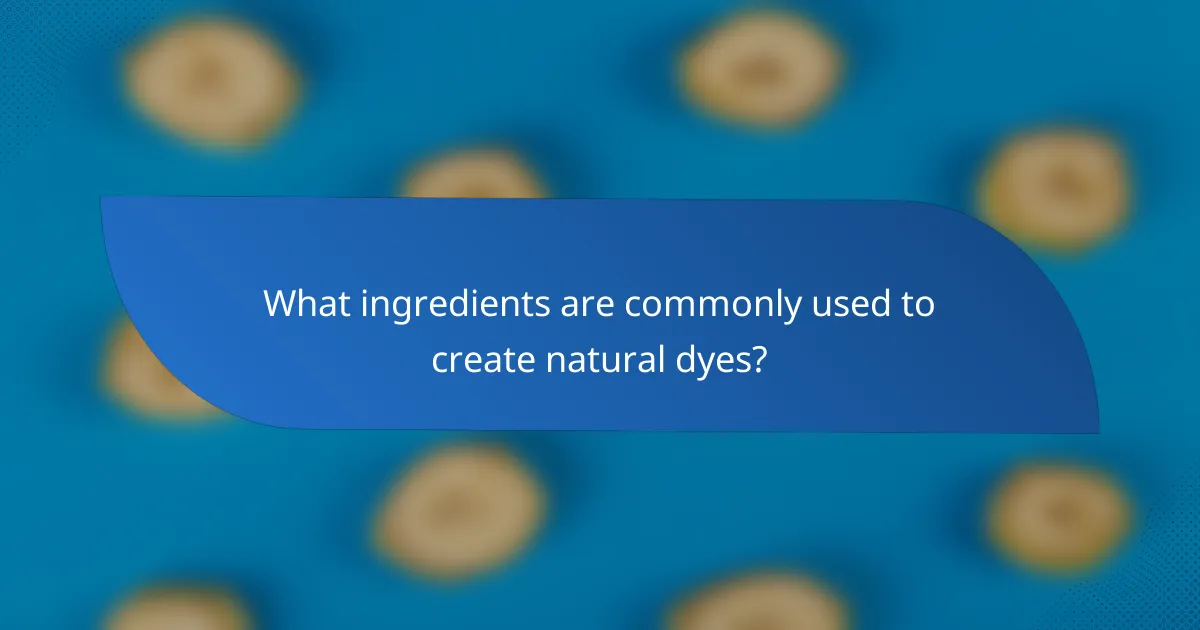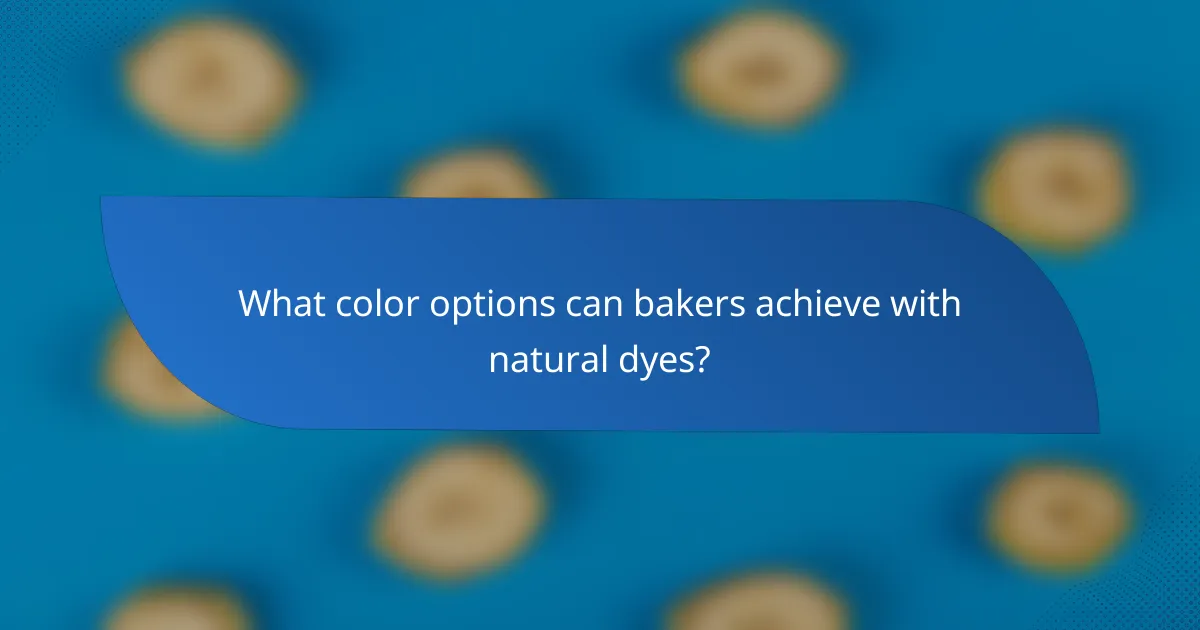Natural dyes for custom cakes are colorants sourced from plants, minerals, or insects, offering a vibrant and safe alternative to synthetic food colorings. Common natural sources include beet juice for red, turmeric for yellow, and spirulina for blue, each contributing unique flavors and health benefits. The article explores various natural ingredients used for dyeing, such as spinach for green and red cabbage for a spectrum of colors. It highlights the advantages of using natural dyes, including their eco-friendliness and absence of artificial additives. Additionally, bakers can achieve a wide range of colors, enhancing the visual appeal of desserts while aligning with sustainable baking practices.

What are Natural Dyes for Custom Cakes?
Natural dyes for custom cakes are colorants derived from plant, mineral, or insect sources. These dyes provide a vibrant and safe alternative to synthetic food colorings. Common natural sources include beet juice for red, turmeric for yellow, and spirulina for blue. Natural dyes are often preferred for their health benefits and eco-friendliness. They contain no artificial additives or preservatives. Additionally, they can enhance the flavor of the cake, as some sources also impart taste. Many bakers use these dyes to create visually appealing and wholesome desserts. The use of natural dyes aligns with current trends towards organic and sustainable baking practices.
How are natural dyes different from synthetic dyes?
Natural dyes are derived from natural sources like plants, minerals, and insects, while synthetic dyes are chemically manufactured. Natural dyes tend to be less vibrant and more muted compared to the bright colors of synthetic dyes. The colorfastness of natural dyes can vary, often fading more quickly with exposure to light and washing. In contrast, synthetic dyes generally offer greater stability and consistency in color. Additionally, natural dyes may require more complex extraction and application processes, while synthetic dyes are easier to use and mix. The safety profile of natural dyes is often perceived as better, as they are less likely to cause allergic reactions. In contrast, some synthetic dyes have been linked to health concerns and regulatory scrutiny.
What sources are used to create natural dyes for cakes?
Natural dyes for cakes are derived from various plant and mineral sources. Common sources include fruits like beets, which produce a deep red color. Other fruits such as blueberries and blackberries can yield blue and purple hues. Vegetables like carrots provide orange shades, while spinach offers green tones. Turmeric, a spice, is used for yellow coloring. Additionally, certain flowers, such as hibiscus, can create vibrant colors. These natural sources are often preferred for their non-toxic properties and health benefits.
What are the common extraction methods for natural dyes?
Common extraction methods for natural dyes include boiling, fermentation, and solvent extraction. Boiling involves immersing plant materials in water to release color compounds. This method is simple and effective for many sources like beetroot and spinach. Fermentation uses microbial action to extract dyes, often yielding vibrant colors from sources like indigo. Solvent extraction involves using alcohol or other solvents to dissolve dye compounds from plant materials. This method is efficient for extracting specific colors from sources like saffron. Each method varies in efficiency, color intensity, and the type of dye extracted.
What are the benefits of using natural dyes in cake decorating?
Natural dyes in cake decorating offer multiple benefits. They provide a healthier alternative to synthetic dyes. Natural dyes are derived from fruits, vegetables, and plants. This makes them free from harmful chemicals. They also enhance the flavor profile of the cake. For example, beet juice adds sweetness along with color. Additionally, natural dyes create unique, vibrant hues. These colors are often more appealing and visually striking. Many consumers prefer natural ingredients for health reasons. Studies show that natural dyes can be less allergenic than artificial options.
How do natural dyes impact the health of consumers?
Natural dyes generally have a positive impact on the health of consumers. They are derived from plant, mineral, or animal sources, making them safer alternatives to synthetic dyes. Unlike artificial dyes, natural dyes are less likely to cause allergic reactions. Research shows that some natural dyes, like beetroot and turmeric, contain antioxidants. These antioxidants can contribute to overall health by reducing oxidative stress in the body. Additionally, natural dyes often do not contain harmful chemicals associated with synthetic dyes. This makes them more suitable for consumers seeking healthier food options. Studies indicate that consumers are increasingly preferring natural ingredients in their food products.
What aesthetic advantages do natural dyes offer for custom cakes?
Natural dyes offer vibrant and unique colors for custom cakes. These colors are derived from fruits, vegetables, and spices. This results in a rich palette that synthetic dyes cannot replicate. Natural dyes create visually appealing designs that enhance the cake’s aesthetic. They also provide a rustic, organic look that is increasingly popular in cake decoration. Additionally, natural dyes can create soft pastels or deep hues, offering versatility in design. The use of natural ingredients can also contribute to a healthier image for the cake. This aligns with consumer preferences for organic and clean-label products.

What ingredients are commonly used to create natural dyes?
Common ingredients used to create natural dyes include plants, fruits, and vegetables. For example, beetroot is used for red hues. Spinach provides green colors, while turmeric is known for its bright yellow. Red cabbage can produce a range of colors from blue to purple. Other ingredients include onion skins for orange and blackberries for deep purples. These natural sources have been historically utilized for dyeing textiles and food, proving their effectiveness.
Which fruits and vegetables are popular for natural cake dyes?
Beetroot, spinach, blueberries, and turmeric are popular fruits and vegetables for natural cake dyes. Beetroot provides a vibrant red color. Spinach yields a green hue. Blueberries create shades of blue to purple. Turmeric is known for its bright yellow. These natural dyes are often preferred for their health benefits and vibrant colors. Many bakers choose them to avoid artificial additives.
How do different fruits and vegetables affect color intensity?
Different fruits and vegetables affect color intensity through their natural pigments. These pigments, such as anthocyanins in berries and carotenoids in carrots, impart distinct colors. The concentration of these pigments determines the intensity of the color. For instance, beets provide a deep red hue due to high betalain content. Spinach offers a lighter green due to lower chlorophyll concentration. Cooking methods can also influence color intensity. Steaming often preserves brighter colors compared to boiling. The ripeness of the fruit or vegetable can further enhance color intensity. Riper fruits typically have higher pigment levels, leading to more vibrant colors.
What are some lesser-known sources of natural dyes?
Lesser-known sources of natural dyes include various plants and materials. For instance, avocado pits can produce a soft pink hue. The skin of pomegranates yields a rich yellow color. Black walnuts provide a deep brown dye. Hibiscus flowers create vibrant red shades. Additionally, turmeric is well-known for its bright yellow dye. Each of these sources has been historically used in textile dyeing and culinary applications. Their use in natural dyeing for cakes is gaining popularity due to their vibrant colors and food-safe properties.
What are the best practices for using natural dyes in cake recipes?
The best practices for using natural dyes in cake recipes include selecting high-quality, fresh ingredients. Common natural dyes come from fruits, vegetables, and spices. For example, beet juice provides a vibrant red color, while turmeric yields a bright yellow hue. It’s crucial to prepare the dyes properly, often by boiling or blending the source material. Straining the mixture helps achieve a smooth consistency without lumps.
When incorporating the dye, gradually add it to the batter until the desired color is reached. Testing the color on a small amount of batter can help gauge the final outcome. Additionally, using acidic ingredients like lemon juice can enhance color brightness.
Keep in mind that natural dyes may not produce the same intensity as artificial colors. Adjustments to the recipe may be necessary to maintain flavor and texture. Lastly, store any leftover dye in an airtight container in the refrigerator for future use.
How can bakers achieve desired color shades with natural dyes?
Bakers can achieve desired color shades with natural dyes by selecting specific plant-based ingredients. For example, beet juice provides a vibrant red, while turmeric yields a bright yellow. The concentration of the dye affects the intensity of the color. Bakers can mix different natural dyes to create unique shades. Additionally, the pH level of the mixture can alter colors; for instance, adding lemon juice to red cabbage juice turns it pink. Using fat-based mediums, like butter or cream, can also enhance color vibrancy. The temperature during baking may change the final shade, so bakers should consider pre-testing colors. Natural dyes are often less stable than synthetic ones, requiring careful handling to maintain desired hues.
What precautions should be taken when using natural dyes?
When using natural dyes, it is essential to take several precautions. First, always conduct a patch test on a small area of the cake to check for any allergic reactions. Natural dyes can cause allergic responses in sensitive individuals. Second, ensure that the sources of the dyes are food-safe and free from contaminants. Many plants and substances can be toxic if ingested. Third, be aware of the potential for color fading over time. Natural dyes may not have the same longevity as synthetic dyes. Fourth, store any unused natural dyes in a cool, dark place to maintain their potency. Lastly, understand that different natural dyes can react differently with various ingredients, which may alter the final color of the cake.

What color options can bakers achieve with natural dyes?
Bakers can achieve a variety of color options with natural dyes. Common colors include red from beets, yellow from turmeric, and green from spinach. Blue can be derived from butterfly pea flowers. Purple shades can result from purple cabbage. Orange hues are often achieved using carrots or annatto seeds. Brown tones can come from cocoa powder or coffee. Each natural dye provides unique shades and intensities. The use of these dyes allows bakers to create visually appealing and vibrant cakes.
What colors can be derived from specific natural dye sources?
Red can be derived from cochineal insects. This dye produces a vibrant crimson color. Yellow can come from turmeric, which yields a bright golden hue. Indigo plants provide a deep blue shade. Green can be achieved using spinach leaves, resulting in a soft green tint. Purple can be sourced from red cabbage, which creates a lavender color. Brown can be derived from walnut hulls, giving a rich earth tone. These natural dye sources have been used historically for coloring foods and textiles.
How do the colors change with different baking processes?
The colors of baked goods change due to various baking processes. Different temperatures and times affect the Maillard reaction and caramelization. The Maillard reaction occurs between amino acids and reducing sugars, creating browning. This reaction intensifies at higher temperatures, leading to darker colors. Caramelization involves the breakdown of sugars, resulting in golden to deep brown hues. Additionally, the pH level during baking can influence color. For example, acidic environments may yield brighter shades, while alkaline conditions can dull colors. These processes are crucial in determining the final appearance of cakes and pastries.
What tips can help achieve vibrant colors using natural dyes?
To achieve vibrant colors using natural dyes, select fresh and high-quality plant materials. Fresh ingredients contain more pigment than dried ones. Use mordants like alum or cream of tartar to fix the color to the fabric or cake. Mordants enhance the vibrancy and longevity of the dye. Experiment with different extraction methods, such as boiling or soaking, to maximize pigment release. Boiling generally yields more intense colors. Adjust the pH of the dye bath; acidic environments can brighten colors, while alkaline can mute them. For example, adding vinegar can intensify red hues from beets. Lastly, test small samples before dyeing larger batches to ensure desired results.
How can bakers experiment with blending different natural dyes?
Bakers can experiment with blending different natural dyes by combining various plant-based pigments. They can start by selecting dyes from sources like beet juice, turmeric, or spirulina. Each dye has a unique color profile and can create a range of hues when mixed. For instance, beet juice produces red, while turmeric yields yellow. Mixing these can result in orange tones.
Bakers should test small batches to see how colors interact. They can adjust ratios to achieve desired shades. Additionally, acidity can alter colors; for example, adding lemon juice can shift beet red to a pink hue.
Using pH indicators, bakers can explore color changes in natural dyes. This experimentation leads to unique color combinations in baked goods. Documenting the process helps replicate successful blends in future projects.
What common challenges might arise when using natural dyes?
Common challenges when using natural dyes include color consistency and fading. Natural dyes often vary in hue due to factors like plant source and extraction method. Achieving a stable color can be difficult, as some dyes may change when exposed to heat or light. Additionally, the intensity of the color can differ based on the ingredient’s freshness. Another challenge is the potential for unexpected flavors, as some natural dyes can impart taste to the final product. Lastly, the availability of specific natural dye sources may be limited, impacting color options for custom cakes.
Natural dyes for custom cakes are colorants sourced from plants, minerals, or insects, offering a safe and vibrant alternative to synthetic food colorings. This article explores the differences between natural and synthetic dyes, common sources and extraction methods, and the health benefits associated with using natural dyes in cake decorating. It also discusses the aesthetic advantages, color options, and best practices for incorporating natural dyes into cake recipes. Additionally, the article addresses potential challenges bakers may face when using these dyes and provides tips for achieving vibrant colors through experimentation and blending techniques.



